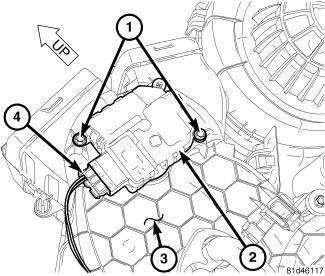Dodge Journey: Actuator, mode door, rear
DESCRIPTION

Fig. 51: Rear Actuator Description
The mode door actuator (1) for the rear heater-A/C system is a reversible, 12 volt direct current (DC), servo motor. The rear mode door actuator is located on the outboard side of the rear heater-A/C housing.
The rear mode door actuator is contained within a black molded plastic housing with an integral wire connector receptacle (2), an output shaft with splines (3) connect it to the rear mode-air door and three integral mounting tabs (4) allow the actuator to be secured to the rear heater-A/C housing. The mode door actuator does not require mechanical indexing to the mode door linkage, as it is electronically calibrated by the A/C-heater control.
The A/C-heater control must be recalibrated each time an actuator motor is replaced.
The rear mode door actuator is interchangeable with the actuator for the rear blend-air door.
OPERATION
The rear mode door actuator is connected to the A/C-heater control through the vehicle electrical system by a dedicated two-wire lead and connector of the rear heater-A/C wire harness. The rear mode door actuator can move the rear mode-air door in two directions. When the A/C-heater control pulls the voltage on one side of the motor connection high and the other connection low, the rear mode-air door will move in one direction. When the A/C-heater control reverses the polarity of the voltage to the motor, the rear mode-air door moves in the opposite direction. When the front A/C-heater control makes the voltage to both connections high or both connections low, the rear mode-air door stops and will not move.
The front A/C-heater control uses a pulse-count positioning system to monitor the operation and relative position of the rear mode door actuator and the rear mode-air door. The front A/C-heater control learns the rear mode-air door stop positions during the calibration procedure and will store a diagnostic trouble code (DTC) for any problems it detects in the rear mode door actuator circuits.
The rear mode door actuator is diagnosed using a scan tool.
The rear mode door actuator cannot be adjusted or repaired and must be replaced if inoperative or damaged.
REMOVAL

Fig. 52: Rear Housing Mode Door Actuator Removal/Installation
1. Disconnect and isolate the negative battery cable.
2. Remove rear heater-A/C housing (3) and place it on a workbench.
3. Disconnect the wire harness connector (4) from the rear mode door actuator (2) located on the outboard side of the rear heater-A/C housing.
4. Remove the two screws (1) that secure the rear mode door actuator to rear heater-A/C housing and remove the actuator.
INSTALLATION

Fig. 53: Rear Mode Door Actuator Align
1. Position the rear mode door actuator (1) onto the rear heater-A/C housing (3). If necessary, rotate the actuator slightly to align the splines on the actuator output shaft with those on the rear mode-air door pivot shaft (2).

Fig. 54: Rear Housing Mode Door Actuator Removal/Installation
2. Install the two screws (1) that secure the rear mode door actuator (2) to the rear heater-A/C housing (3).
Tighten the screws to 1.2 N.m (10 in. lbs.).
3. Connect the wire harness connector (4) to the rear mode door actuator.
4. Install the rear heater-A/C housing.
5. Initiate the Actuator Calibration function using a scan tool.
 Actuator, blend door, rear
Actuator, blend door, rear
DESCRIPTION
Fig. 47: Rear Actuator Description
The blend door actuator (1) for the rear heating-A/C system is a reversible,
12 volt direct current (DC), servo
motor. The rear blend door actuato ...
 Control, A/C and heater, rear
Control, A/C and heater, rear
DESCRIPTION
The A/C-heater controls allows the driver and front seat passenger and the
intermediate seat passengers the
ability to regulate air temperature as well as fan speed for the rear
heat ...
See also:
Pump, engine oil
Removal
Fig. 275: Oil Pump & Pick-up Tube
- BOLTS
- O-RING
- PICK-UP TUBE
- BOLT
- OIL PUMP
NOTE: The oil pump pressure relief valve can be serviced by removing
the oil pan ...
Installation
2.4L
Fig. 52: 2.4L Knock Sensor
CAUTION: Always torque knock sensors to the correct torque
specification. Over or
under tightening effects knock sensor performance. Ensure the electr ...
Transmission
COOLER, TRANSMISSION OIL
Description
Fig. 128: TRANSMISSION OIL COOLER
- Air Conditioning Condenser/Transmission Oil Cooler
- Transmission Cooler Outlet
- Transmission Cooler Inlet
- Air ...
